NVIDIA's 1.4 Billion Transistor GPU: GT200 Arrives as the GeForce GTX 280 & 260
by Anand Lal Shimpi & Derek Wilson on June 16, 2008 9:00 AM EST- Posted in
- GPUs
Building NVIDIA's GT200
Here's a Streaming Processor, NVIDIA calls it an SP:

NVIDIA calls an individual SP a single processing core, which is actually true. It is a fully pipelined, single-issue, in-order microprocessor complete with two ALUs and a FPU. An SP doesn't have any cache, so it's not particularly great at anything other than cranking through tons of mathematical operations. Since an SP spends most of its time working on pixel or vertex data, the fact that it doesn't have a cache doesn't really matter. Aside from name similarities, one NVIDIA SP is a lot like a very simplified version of a SPE in the Cell microprocessor (or maybe the SPE is like a really simple version of one of NVIDIA's SMs, which we'll get to in a minute). While a single SPE in Cell has seven execution units, a single NVIDIA SP only has three.
By itself a SP is fairly useless, but NVIDIA builds GPUs and if you add up enough of these little monsters you can start to get something productive given that graphics rendering is a highly parallelizable task.
Here's a Streaming Multiprocessor, which NVIDIA abbreviates as SM:

A SM is an array of SPs, eight to be specific, along with two more processors called Special Function Units (SFUs). Each SFU has four FP multiply units which are used for transcendental operations (e.g. sin, cosin) and interpolation, the latter being used in some of the calculations for things like anisotropic texture filtering. Although NVIDIA isn't specific in saying so, we assume that each SFU is also a fully pipelined, single-issue, in-order microprocessor. There's a MT issue unit that dispatches instructions to all of the SPs and SFUs in the group.
In addition to the processor cores in a SM, there's a very small instruction cache, a read only data cache and a 16KB read/write shared memory. These cache sizes are kept purposefully small because unlike a conventional desktop microprocessor, the datasets we're trying to cache here are small. Each SP ends up working on an individual pixel and despite the move to 32-bit floating point values, there's only so much data associated with a single pixel. The 16KB memory is akin to Cell's local stores in that it's not a cache, but a software-managed data store so that latency is always predictable. With this many cores in a single SM, control and predictability and very important to making the whole thing work efficiently.
Take one more step back and you've got a Texture/Processor Cluster (TPC):
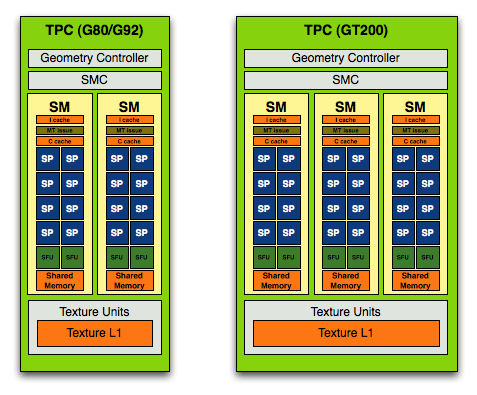
The G80/G92 TPC (left) vs. the GT200 TPC (right)
NVIDIA purposefully designed its GPU architecture to be modular, so a single TPC can be made up of any number of SMs. In the G80 architecture it was made up of two SMs but with the GT200 architecture it now has three SMs.
The components of the TPC however haven't changed; a TPC is made up of SMs, some control logic and a texture block. Remember that a SM is a total of 8 SPs and 2 SFUs, so that brings the total up to 24 SPs and 6 SFUs (must...not...type...STFU) per cluster in GT200 (up from 16 SPs and 4 SFUs in G80). The texture block includes texture addressing and filtering logic as well as a L1 texture cache.
The modular theme continues with the Streaming Processor Array (SPA) that is composed of a number of TPCs:
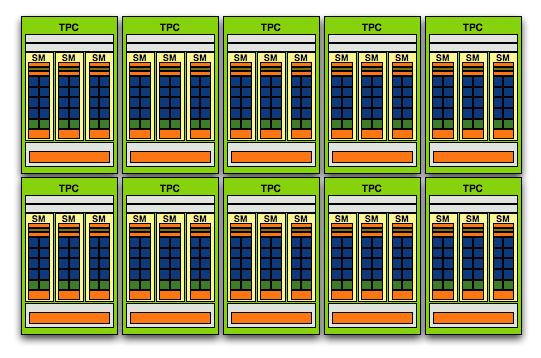
The GT200 SPA, that's 240 SPs in there if you want to count them
In G80 the SPA was made up of 8 TPCs, but with GT200 we've moved up to 10. Note that each TPC now has 3 SMs vs. 2, so the overall processing power of GT200 has increased by 87.5% over G80.
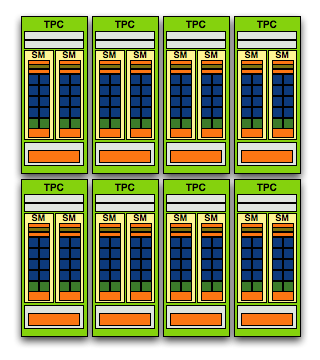
And here's G80/G92, only 128 SPs thanks to two SMs per TPC and 8 TPCs
At the front end of the GPU we've got schedulers and control logic to distribute workloads to the entire array of processing cores. At the other end we've got L2 texture caches and rasterization processors that handle final filtering and output of data to the frame buffer.
The culmination of all of this is that the new GT200 GPU, the heart of the GeForce GTX 280 and 260, features 240 SPs, 160KB of local memory, an even smaller amount of cache and is built on TSMC's 65nm process using 1.4 billion transistors.
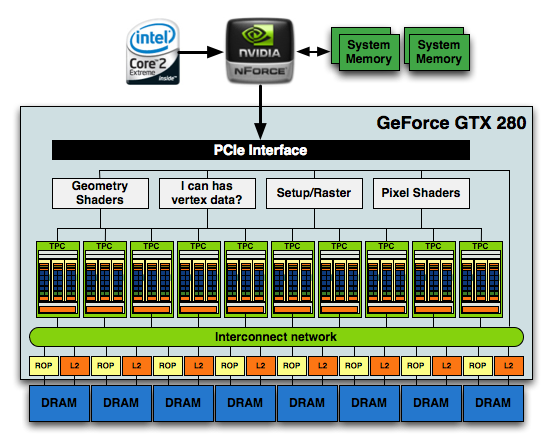
1.4 Billion Transistors. It wants vertex data. Really bad.
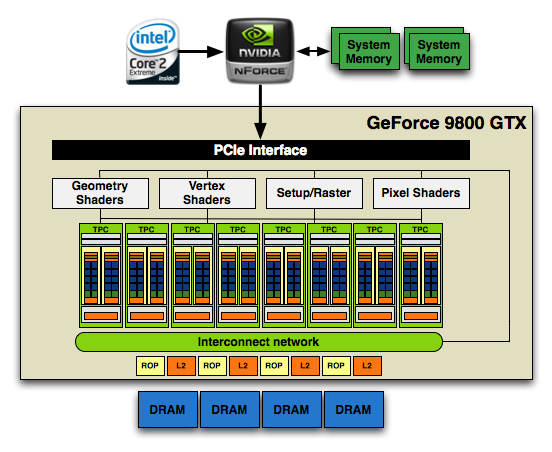
754 Million Transistors
There are more transistors in this chip than there are people in China, and it's the largest, most compute-dense chip we've ever reviewed.










108 Comments
View All Comments
Chaser - Monday, June 16, 2008 - link
Maybe I'm behind the loop here. The only competition this article refers to is some up coming new INTEL product in contrast to an announced hard release of the next AMD GPU series a week from now?BPB - Monday, June 16, 2008 - link
Well nVidia is starting with the hi end, hi proced items. Now we wait to see what ATI has and decide. I'm very much looking forward to the ATI release this week.FITCamaro - Monday, June 16, 2008 - link
Yeah but for the performance of these cards, the price isn't quite right. I mean you can get two 8800GTs for under $400 and they typically outperform both the 260 and the 280. Yes if you want a single card, these aren't too bad a deal. But even the 9800GX2 outperforms the 280 normally.So really I have to question the pricing on them. High end for a single GPU card yes. Better price/performance than last generations card, no. I just bought two G92 8800GTSs and now I don't feel dumb about it because my two cards that I paid $170 for each will still outperform the latest and greatest which cost more.
Rev1 - Monday, June 16, 2008 - link
Maybe lack of any real competition from ATI?hadifa - Monday, June 16, 2008 - link
No, The reason is high cost to produce. over a Billion transistors, low yields, 512 bit bus ...
Unfortunately the high cost and the advance tech doesn't translate to equally impressive performance at this stage. For example, if the card had much lower power usage under load, still it would have been considered a good move forward for having comparable performance to a dual GPU solution but with much cooler running and less demanding hardware.
As the review mentions, this card begs for a die shrink. It will make it use less power, be cheaper, run cooler and even have a higher clock.
Warren21 - Monday, June 16, 2008 - link
That competition won't come for another two weeks, but when it does -- rumour has it NV plan to lower their prices. Most preliminary info has HD 4870 at 299-329 and pretty much GTX 260 performance, if not, then biting at it's heels.smn198 - Tuesday, June 17, 2008 - link
You haven't seen anything yet. check out this picture of the GTX2 290!! http://tinypic.com/view.php?pic=350t4rt&s=3">http://tinypic.com/view.php?pic=350t4rt&s=3Mr Roboto - Wednesday, June 18, 2008 - link
Soon it will be that way if Nvidia has their way.